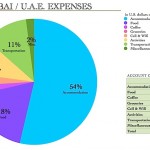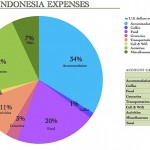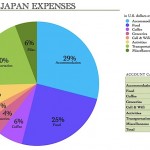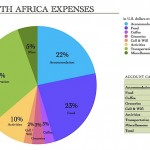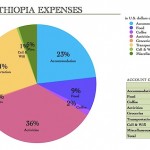Check out this post — Expense Report: Pre-Trip Costs — for a better understanding of other costs associated with a RTW trip, as well as a definition of my travel style and how it impacts my budget.
Oh, Nepal… you won me over. Great restaurants, unparalleled trekking, kind people, and a favorable exchange rate with the USD are a few reasons I fell in love. Let’s dig deeper into that last one.
Here’s what I spent in U.S. dollars over 25 nights in Nepal:
- Accommodation = $206.79 … $8.27 per night
- Food = $359.09 … $14.36 per day
- Groceries = $90.79 … $3.63 per day
- Coffee = $26.66 … $1.06 per day
- Activities = $344.91 … $13.79 per day
- Cell & Wifi = $2.52 … $0.10 per day
- Transportation = $395.72 … $15.82 per day
- Miscellaneous = $459.15 … $18.36 per day
And the grand total for 25 nights in Nepal is…:
$1,885.63 USD, which works out to $75.42 per day.
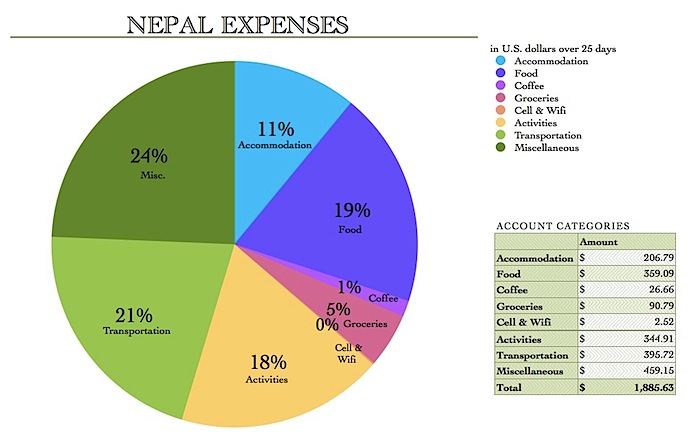
Here’s how those numbers compare with other countries I’ve traveled to:
- My daily average in Cook Islands: $157.05
- My daily average in New Zealand: $88.56
- My daily average in Australia: $83.37
- My daily average in Singapore: $78.86
- My daily average in Indonesia: $51.34
- My daily average in Malaysia: $117.09
- My daily average in Palau: $160.91
- My daily average in Philippines: $49.21
- My daily average in Japan: $89.55
- My daily average in Nepal: $75.42
Airfare to Nepal = $565… Average night’s sleep = $8.27… Posing for this photo? Priceless.
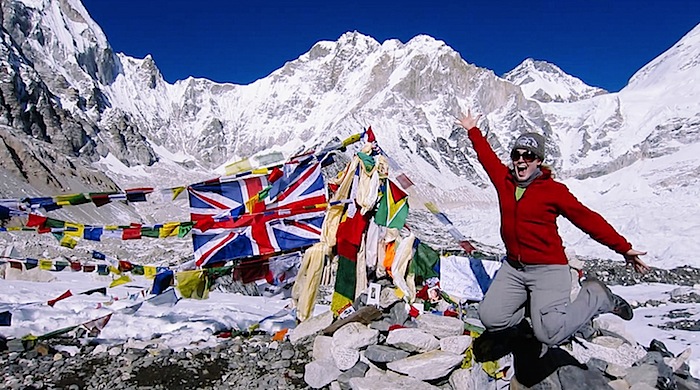
A few notes:
- I used xe.com in mid-October to calculate the exchange rate and at that point in time, 1 NPR (Nepalese Rupee) = .0101 USD.
- I did not receive any blog discounts while traveling through Nepal, so these numbers are quite accurate to what a typical backpacker might spend visiting this part of the world.
- I did not include my flights into or out of Nepal, since I will note international flights on a separate RTW airfare budget at the end of my trip. Domestic flights are noted under Transportation.
- I did not purchase a SIM card in Nepal. I almost bought one at the airport, but midway through the transaction the employee says there’s no data plan, just calling / texting — which I had specifically asked about up front, and he had answered in the affirmative… so we had our signals crossed. Since I was trekking in remote areas for half of my time in Nepal, I decided to forgo a SIM card and instead connect via wifi at my accommodations. Most cafes and restaurants in Kathmandu offer free wifi, too. I continued to use the Viber app to communicate for free with my friends and family back home.
- I continued to use my Charles Schwab debit card to avoid international ATM fees.
- My daily average is high for a few reasons, the first being my Everest Base Camp trek. I spent about $200 on supplies ($150 on gear and $50 on meds and groceries, all included under the Miscellaneous category). My round-trip flight to Lukla costs $324, noted under Transportation. My guide / porter cost $264 plus tip (or $22 per day on my 12-day trek), listed under Tours / Activities. And my TIMS permit and conservation fee totaled $50. If you add in accommodation and food during the trek, those costs total around $215, which brings the entire cost of my Everest Base Camp trek to $1,050 USD. If you plan to bring your own gear from home, then it’s only $850 USD. The prices of similar tours offered by western companies (like G Adventures and Intrepid) cost around $1,400 USD… so I saved hundreds of dollars by arranging it myself.
- I bought all of my trekking gear in Thamel upon my arrival. There are dozens of shops and prices are far less than what I’d pay back home in the States. I picked up a -10 degrees North Face sleeping bag for $45 (your guess is as good as mine if it’s the real thing or a knock-off), a Mountain Hardwear rainproof jacket / shell for $25, a waterproof North Face duffel bag to carry everything in for $12, new trekking pants for $17, thermals for $12, three pairs of wool socks at $1.50/each, two pairs of thick trekking socks for $3/each, one lightweight hat and two heavy hats for $10 total (the second heavy hat was a fashion decision), heavy-duty gloves for $5, back-up sunglasses for $3, slip-on sandals to go over my socks (convenient for nighttime bathroom visits) for $3, deck of cards for $1.50, and a Lonely Planet Nepal book for $8 (I paid $15 but then got $7 back from one of the local used bookstores when I returned it at the end of my trip).
- Prior to this destination I’d only purchased one souvenir on my RTW trip (hand-painted postcards in Kyoto). But the streets of Kathmandu are teeming with stores and the holidays were fast approaching, so I splurged. I bought myself three scarves and a few more for my mother. I picked up the one and only t-shirt of my entire trip (it has the map of Everest Base Camp printed on the back). And I purchased a $25 down jacket since I don’t own one at home and it’s cheaper to buy them here. All of these items total $70 and are counted under the Miscellaneous category.
- A huge cost under Miscellaneous was $115 to ship that 10kg box back home to the States. After investing in all this well-priced gear, I wanted to keep it for future travels. I shopped around in Kathmandu and the lowest price I found for a courier service was $115 via the Dutch shipping company TNT. It takes only 4 days to ship back to the States (which wasn’t important as I only needed it to arrive by Christmas, but cheaper seamail shipping takes about three months). My other option was to just pay the extra baggage fee and tote the trekking gear around with me another six weeks until I returned to the States, but that sounded like a giant pain and it might end up costing me the same anyway once you factor in airline fees for the five additional countries I had yet to visit. If you are flying directly back to the States after your Nepal trek, it’d be easiest just to pay for an extra bag on your return flight.
- If you are NOT trekking, Nepal is more affordable than my daily $75 budget suggests, and you can live like a king or queen on $40 USD per day in Kathmandu. I paid $15/night for my private room with bathroom, got a decent breakfast and coffee for $4, lunch for $7, and dinner for $9. Throw in an extra $5/day for miscellaneous expenses and that’s $40 per day total. You could go even cheaper, as some restaurants don’t charge tax and gratuity (a whopping 23%), meaning you can get a decent dinner and drink for $5. The Thamel district in Kathmandu has maybe a hundred restaurants within a few blocks and the food is GOOD. I love trying new places and returning to favorite haunts. There are bakeries everywhere. I suspect my food budget is higher than average.
- My daily average for accommodation — $8.27 per night — is a little wonky as most of the tea houses I stayed in while trekking to Everest Base Camp were $3 per night, but in Kathmandu my private room was $15 per night. It averages out to $8/night even though I never paid that mid-range amount.
- I’ll wrap up by admitting I’m surprised that I spent as much as I did in Nepal. If you’re considering your own trip, I hope that number doesn’t discourage you. You could bring your own gear, trek for cheaper elsewhere (Lukla is an expensive flight but accessing the Annapurna circuit via Pokhara is cheaper), and cut down on your food budget while still eating well.
- Note: a 30-day entrance visa for Nepal costs $40 USD. If you want to stay longer than 30 days, there is a 100-day visa available for $100.
I hope that this has been informative for anyone planning their own trip to this part of the world.

